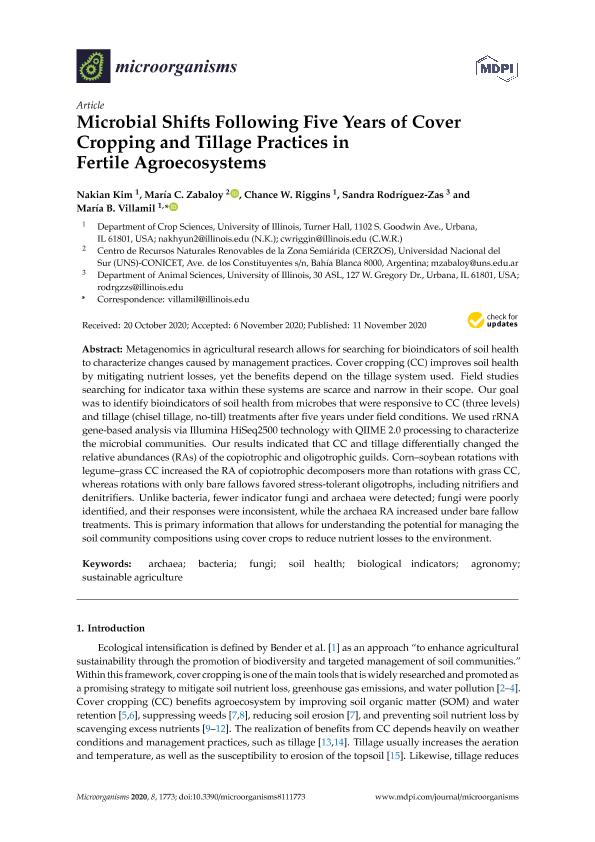Mostrar el registro sencillo del ítem
dc.contributor.author
Kim, Nakian
dc.contributor.author
Zabaloy, Maria Celina

dc.contributor.author
Riggins, Chance W.
dc.contributor.author
Rodríguez Zas, Sandra
dc.contributor.author
Villamil, Maria Bonita

dc.date.available
2021-01-05T12:35:59Z
dc.date.issued
2020-11
dc.identifier.citation
Kim, Nakian; Zabaloy, Maria Celina; Riggins, Chance W.; Rodríguez Zas, Sandra; Villamil, Maria Bonita; Microbial shifts following five years of cover cropping and tillage practices in fertile agroecosystems; MDPI AG; Microorganisms; 8; 11; 11-2020; 1-21,1773
dc.identifier.issn
2076-2607
dc.identifier.uri
http://hdl.handle.net/11336/121469
dc.description.abstract
Metagenomics in agricultural research allows for searching for bioindicators of soil health to characterize changes caused by management practices. Cover cropping (CC) improves soil health by mitigating nutrient losses, yet the benefits depend on the tillage system used. Field studies searching for indicator taxa within these systems are scarce and narrow in their scope. Our goal was to identify bioindicators of soil health from microbes that were responsive to CC (three levels) and tillage (chisel tillage, no-till) treatments after five years under field conditions. We used rRNA gene-based analysis via Illumina HiSeq2500 technology with QIIME 2.0 processing to characterize the microbial communities. Our results indicated that CC and tillage differentially changed the relative abundances (RAs) of the copiotrophic and oligotrophic guilds. Corn–soybean rotations with legume–grass CC increased the RA of copiotrophic decomposers more than rotations with grass CC, whereas rotations with only bare fallows favored stress-tolerant oligotrophs, including nitrifiers and denitrifiers. Unlike bacteria, fewer indicator fungi and archaea were detected; fungi were poorly identified, and their responses were inconsistent, while the archaea RA increased under bare fallow treatments. This is primary information that allows for understanding the potential for managing the soil community compositions using cover crops to reduce nutrient losses to the environment.
dc.format
application/pdf
dc.language.iso
eng
dc.publisher
MDPI AG
dc.rights
info:eu-repo/semantics/openAccess
dc.rights.uri
https://creativecommons.org/licenses/by/2.5/ar/
dc.subject
AGRONOMY
dc.subject
ARCHAEA
dc.subject
BACTERIA
dc.subject
BIOLOGICAL INDICATORS
dc.subject
FUNGI
dc.subject
SOIL HEALTH
dc.subject
SUSTAINABLE AGRICULTURE
dc.subject.classification
Ciencias del Suelo

dc.subject.classification
Agricultura, Silvicultura y Pesca

dc.subject.classification
CIENCIAS AGRÍCOLAS

dc.subject.classification
Biología Celular, Microbiología

dc.subject.classification
Ciencias Biológicas

dc.subject.classification
CIENCIAS NATURALES Y EXACTAS

dc.title
Microbial shifts following five years of cover cropping and tillage practices in fertile agroecosystems
dc.type
info:eu-repo/semantics/article
dc.type
info:ar-repo/semantics/artículo
dc.type
info:eu-repo/semantics/publishedVersion
dc.date.updated
2020-12-04T14:44:58Z
dc.journal.volume
8
dc.journal.number
11
dc.journal.pagination
1-21,1773
dc.journal.pais
Suiza

dc.journal.ciudad
Basel
dc.description.fil
Fil: Kim, Nakian. University of Illinois; Estados Unidos
dc.description.fil
Fil: Zabaloy, Maria Celina. Consejo Nacional de Investigaciones Científicas y Técnicas. Centro Científico Tecnológico Conicet - Bahía Blanca. Centro de Recursos Naturales Renovables de la Zona Semiárida. Universidad Nacional del Sur. Centro de Recursos Naturales Renovables de la Zona Semiárida; Argentina
dc.description.fil
Fil: Riggins, Chance W.. University of Illinois; Estados Unidos
dc.description.fil
Fil: Rodríguez Zas, Sandra. University of Illinois; Estados Unidos
dc.description.fil
Fil: Villamil, Maria Bonita. University of Illinois; Estados Unidos. Consejo Nacional de Investigaciones Científicas y Técnicas; Argentina
dc.journal.title
Microorganisms
dc.relation.alternativeid
info:eu-repo/semantics/altIdentifier/url/https://www.mdpi.com/2076-2607/8/11/1773
dc.relation.alternativeid
info:eu-repo/semantics/altIdentifier/doi/http://dx.doi.org/10.3390/microorganisms8111773
Archivos asociados
